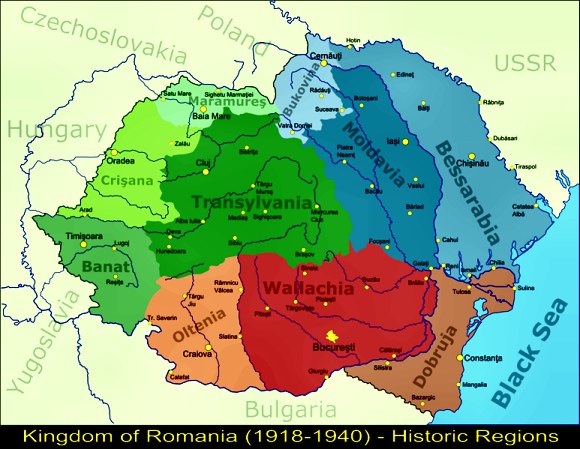
During World War I Romania fought with France and Britain against Austria and Hungary. After the war, it was awarded parts of Hungary, Bulgaria and Ukraine, and the country more than doubled in size. However, Romania was still poor and very economically backward – 72% of the population worked in agriculture – and the country found it difficult to assimilate its new population. Many of its new citizens were Jewish, who accounted for 4.2% of Romania’s population. Anti-Semitism was quite commonplace and considered socially acceptable in the Romania of those times.
Politically Romania was dominated by the Liberal Party, which became increasingly conservative and nationalistic, and the right-wing National Peasant Party, which became increasingly authoritarian and nationalistic. There were no true centre parties, and only a small socialist and a tiny communist party. Elections in Romania were typically fraudulent and the results manipulated.
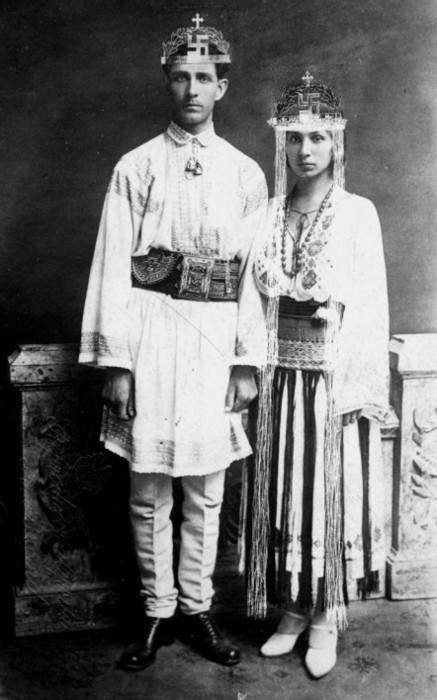
Codreanu and his bride at their wedding in 1925.
Corneliu Zelea Codreanu was born in 1899 in Huşi, which is now close to the border with Moldova. Too young to fight in the First World War, he moved to Iași in 1919 to study law. Though communism had very little presence or influence in Romania at that time, he maintained that he learned his anti-communism there while fighting communists on the street. Like the young Hitler, he despised the Soviet Union, which bordered Romania, and associated communism with the Jews. He had a deeply mystical sense of Romanians as a race, and, though he was also a fervent member of the Romanian Orthodox Church, his anti-semitism was racist above all. While in Iași, he fell under the influence of Professor Alexandru Cuza, who in 1923 founded the anti-Semitic National Christian Defence League, which used the swastika as its symbol. Later that year, Codreanu was charged with plotting to kill the Prime Minister and other government members, after they had passed laws giving equal rights to Jewish citizens, but he was acquitted because he had not set a date for the assassinations. Codreanu claimed to have had a vision of the Archangel Michael while in prison awaiting trial.
In 1924 Codreanu shot and killed a police prefect who had earlier beaten him while breaking up one of his political meetings. At his trial he was acquitted by jury members who were sympathetic to the League. In 1927 Codreanu urged Cuza to transform the League into a revolutionary paramilitary grouping, in effect a proto-fascist party, but Cuza was opposed to this. He then broke with Cuza to form the Legion of the Archangel Michael. Like other fascists, Codreanu favoured action over theory, claiming, “The country is dying for lack of men and not for lack of political programs.” He also professed his desire to create a “new man”. This was a standard aim among fascists, who considered their society and country to be decadent and degenerate and therefore in need of complete regeneration. This desire can also be seen in Hitler’s “New Order” and in the very name of the modern Greek Neo-Nazi party, “Golden Dawn”.
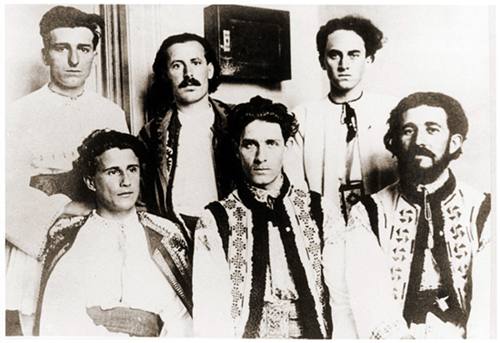
Codreanu and his thuggish comrades.
The Legionaries were fanatically religious. They believed that life consisted of violent struggle, both political and spiritual, and that there was nothing greater than to die for one’s country, race and faith. Their exaltation of self-sacrifice was tinged with religious fervour. The Legion introduced Orthodox rituals as part of its political rallies, while Codreanu made his public appearances dressed in folk costume. In common with the Nazis, he worshipped “Blood and soil” and held a romanticised view of the peasantry. Tall, handsome and charismatic, he would dazzle peasant audiences by riding into political meetings mounted on a white horse. But he was also a pathological anti-Semite. From Wikipedia:
Codreanu began openly calling for the destruction of Jews, and, as early as 1927, the new movement organized the sacking and burning of a synagogue in the city of Oradea. It thus profited from an exceptional popularity of antisemitism in Romanian society: according to one analysis, Romania was, with the exception of Poland, the most antisemitic country in Eastern Europe.
The Legion developed in a distinctly fascist direction, adopting the fascist salute and wearing paramilitary uniform, often with a swastika armband, and including a green shirt to symbolise the regeneration of Romania. Like the Nazis, the Legionaries were fanatically and violently anti-Semitic.
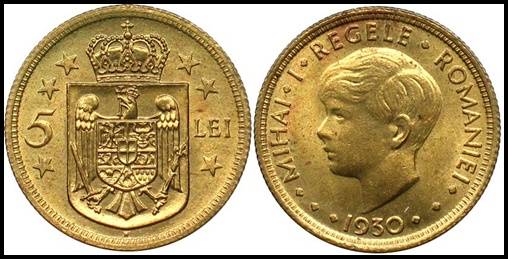
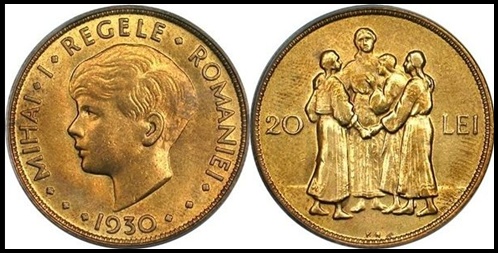
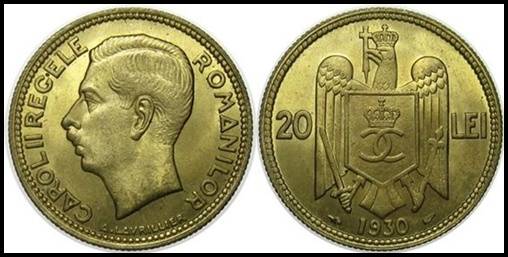
At the invitation of politicians who were dissatisfied with the regency, Prince Carol returned to the country on 7th June 1930 and was proclaimed king by parliament. The historian Stanley Payne describes King Carol II as the most cynical, corrupt and power-hungry monarch ever to disgrace a twentieth century European throne.
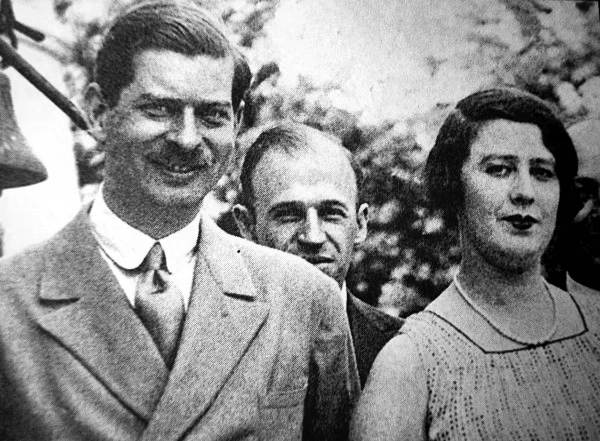
Carol II and his mistress, Elena Lupescu. Though Catholic, her parents had converted from Judaism to Christianity.
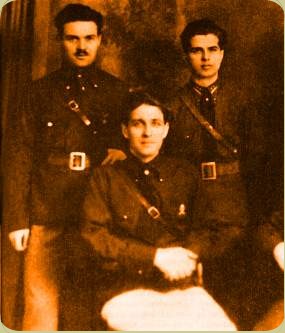
In 1930 the Legion created its own paramilitary arm, called the Iron Guard, just as Hitler had his Storm Troopers. Thereafter the Legion itself was often referred to as the Iron Guard. Codreanu also created Legionary death squads, numbering ten members or fewer. As part of their initiation rituals, they sucked blood from slashes that had been cut into the arms of other members. They then wrote oaths in their own blood, pledging to kill if ordered to. Squad members contributed their blood to a common glass, from which all drank, uniting them in life and death. (What is it with Romanians and blood? Count Dracula and Vlad Țepeș have a lot to answer for).
The government clamped down on the Legion from July 1930 onwards, after it had tried to provoke a wave of pogroms in Maramureş and Bessarabia. In one notable incident of 1930, Legionaries encouraged the peasant population of Borşa to attack the town’s 4,000 Jews. The Legion had also attempted to assassinate government officials and journalists — including Constantin Angelescu, undersecretary of Internal Affairs. Codreanu was briefly arrested together with the would-be assassin Gheorghe Beza: both were tried and acquitted. Nevertheless, the wave of violence and a planned march into Bessarabia caused the government to outlaw the party in January 1931; again arrested, Codreanu was acquitted in late February. To escape the ban, the party changed its name to the Codreanu Group and won 5 parliamentary seats in the general election of 1932.
In November 1933 King Carol II asked Ion Duca to head the government as prime minister in preparation for the December elections. Duca now moved against the Legion, which he considered to be dangerous and pro-Nazi, and also banned their political arm. Police on orders from Duca attacked and sometimes tortured Iron Guard members, which led to the deaths of some of them, and jailed around 1700 of them. On 30th December three Iron Guard members shot and killed Duca on the platform of Sinaia railway station in a revenge attack. All three of them were sentenced to jail for the murder. Because they were banned, the Legionaries had no political representation in the new parliament. The National Liberal Party won the elections and governed for the next four years.
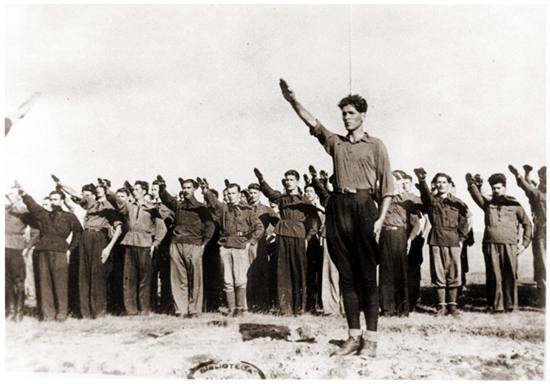
In response to the ban on the Legionaries, in 1934 Codreanu formed a political party called “Everything for the Country” (“Totul Pentru Ţară”, sometimes translated in English as “All for the Fatherland”). The party was led by a general, but it was merely a front for the Legionaries.
In 1935 the National Agrarian Party and the National Christian Defence League merged to form the National Christian Party. The party was authoritarian, right-wing, and extremely anti-Semitic. It formed its own paramilitary group, known as the Lăncieri or Lance-bearers, who wore a blue-shirted uniform and a swastika armband. The Lăncieri and the Iron Guard were deadly opponents and often fought street battles, in addition to attacking Jews. Pity the poor Romanian Jews, who had to live in such an atmosphere.
Political scientists regard the National Christian Party not as fascist, but as pseudo-fascist. Apart from its anti-Semitism, it had no desire to reform the whole of society in a totalitarian fascist direction; it was in fact conservative in a reactionary and old-fashioned sense. It simply wanted people to know their place and stay out of politics if they did not agree with its message. True fascists, such as the Legionaries, were totalitarian, not merely authoritarian: they thought that if you were not with them, you were against them, so they required the whole population to engage in their activities and in the transformation of society and the state.
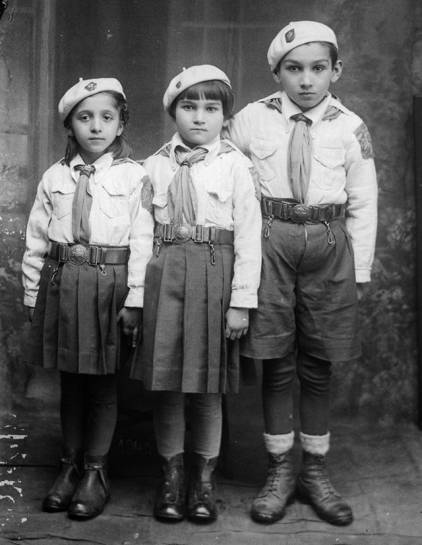
Also in 1935, Carol II formed his own paramilitary youth organisation, known as Straja Țării, The Sentinel of the Country, to counter the growing influence the Iron Guard had over the youth of Romania. Its members were known as străjeri (“sentinels”) and used the fascist salute as a greeting. The monarch modelled it on the Hitler Youth and the Italian Fascist Balilla. This became more obvious on December 3, 1938, when Straja Țării was re-organized along the lines of Carol’s personal regime replacing all existing youth movements, including Scouting, and became overseer of sports and all other activities. Its slogan was “Faith and work for country and king”. Credință și muncă pentru Țară și Rege.
The following year the Legion was involved in another atrocity. Mihai Stelescu, an ex-Legionary who had formed his own extremist group, was recovering in his hospital bed after an appendectomy, when a Legionary death squad, who considered him a traitor, burst in and shot him between 38 and about 200 times on July 16, 1936. They then cut him into pieces with axes and danced around his body. Arrested immediately, the men were sentenced to hard labour for life.
In the last months of 1937, by which time the Legion had around 200,000 members, Codreanu made several pro-German speeches. Romania’s expanded territory had been won at the expense of Germany’s former allies, making King Carol wary of Hitler’s growing power. Another general election was held in December 1937, and this time “Everything for the Country” made an electoral pact with the increasingly anti-Semitic National Peasants Party.
The National Liberal Party won 152 seats, with 36.5% of the vote; the National Peasants Party won 86 seats (20.7%); while Everything for the Country won 66 seats (15.8%). Together, the National Peasants and Everything for the Country pact had 152 seats, the same as the National Liberals, so there was a tie. As a result, King Carol chose Octavian Goga of the National Christian Party, which had received only 9.3% of the vote, to head a minority government. However, the chief of the police later admitted privately that “Everything for the Country” had actually won just over 25% of the vote in its own right, so in truth it was Romania’s most popular party. Evidently the King had arranged for the figures to be manipulated to show an apparent tie.
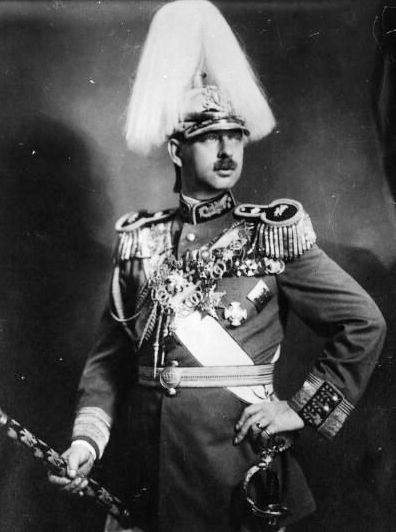
King Carol II in 1938.
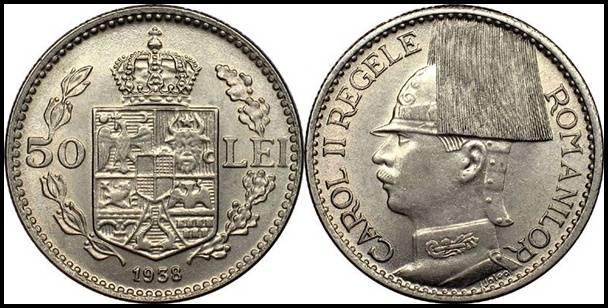
In January 1938 the National Christian Party effectively stripped most Romanian Jews of their citizenship by setting an impossibly high bar for documentary proof of such citizenship. Jewish businesses were closed down; the resulting disruption took down many non-Jewish businesses and caused massive capital flight. The journalist Alexander Easterman wrote that “Goga proclaimed his policy, openly and unashamed, as designed to rid Romania of the Jews. Indeed, he had no other policy to offer; his government was quite simply anti-Semitic and nothing else”. Easterman hypothesises that Carol had placed this party in power “to give his people a taste of fascism”, hoping that a reaction against such policies would sweep away not only the relatively weak National Christians but also the far stronger Iron Guard.
The former rivals, Goga and Codreanu, now signed a pact on February 8th 1938. This alarmed King Carol, who initiated a royal coup d’état and deposed the Goga government on February 10th. He formed a new government, led by Miron Cristea, Patriarch of the Romanian Orthodox Church. Romania was now governed by a royal dictatorship.
In March 1938, a government minister, Nicolae Iorga, accused Codreanu of serving Nazi interests and financing rebellion. Codreanu sent him an angry letter, accusing him of hypocrisy. Two weeks previously Hitler had annexed Austria, alarming King Carol and his government, who were now determined to crack down on Codreanu and his Legion. The Minister of the Interior, Armand Călinescu, therefore had Codreanu arrested for libelling a minister. The Minister of Defence, General Ion Antonescu, who later became dictator of Romania, gave evidence in Codreanu’s defence, but he was nevertheless sentenced to six months in prison. Antonescu resigned his government post in protest. Codreanu was then additionally accused of treason because of his Legionary activities and sentenced to 10 years’ hard labour, along with 44 of his top Legionaries. In November 1938 Carol visited Hitler, who offered his full support if Carol would get rid of his semi-Jewish mistress and release Codreanu from prison. Carol refused and returned to Romania.
On 24th November a Legionary death squad assassinated a relative of Călinescu. On 30th November it was announced that Codreanu and thirteen other Legionaries (members of his death squads) had been shot dead while trying to escape from prison. This incident became known in Romania as “The Night of the Vampires” – the Legionary death squads were notorious for their blood-drinking rituals. Much later the true story emerged: King Carol had ordered the Legionaries to be taken from prison and garrotted with wire. Meanwhile the remaining top Legionaries, including Horia Sima, their new leader, fled to Germany, where they began plotting revenge against the regime’s officials.
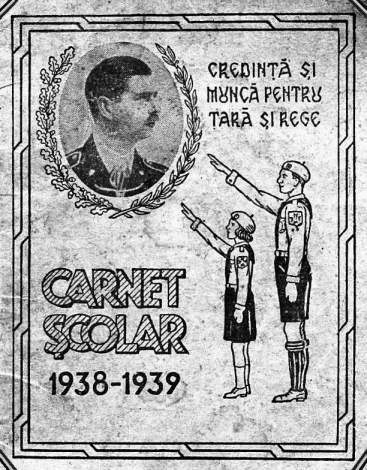
School notebook, 1938-1939. “Faith and work for country and king.”
In December 1938 King Carol created his own political party, the National Renaissance Front, which all members of the government were required to join. Jews were denied membership, but no new anti-Semitic laws were enacted. Romania was now a one party state. The government was organised on corporatist lines, imitating the structure of Mussolini’s regime. Party members wore special uniforms and ceremonial hats, and the fascist salute was mandatory. This was clearly an attempt to appease Hitler and Mussolini, but critics ridiculed it as “operetta fascism”.
On 3rd December 1938, Straja Țării was re-organised along the lines of Carol’s personal regime. It replaced all existing youth movements, including Scouting, and became overseer of sports and all other activities. Its slogan was “Faith and work for country and king”: Credință și muncă pentru Țară și Rege.
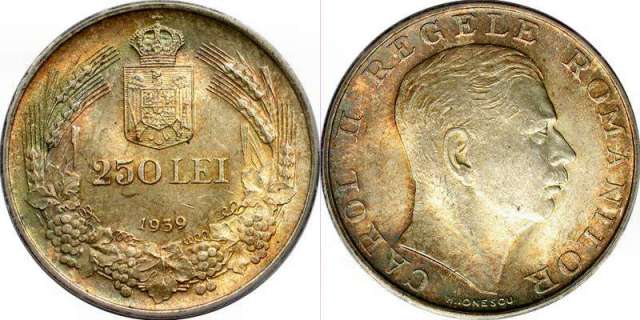 250 lei, 1939.
250 lei, 1939.

The edge inscription shows the motto of the King’s pseudo-fascist regime: MUNCA CREDINTA REGE NATIUNE (“Work, faith, king, nation”).
In March 1939 Călinescu became prime minister. On 21st September 1939, while being driven in his official car in Bucharest, he was ambushed and shot dead by Legionaries. They were caught, and a harsh repression of the Iron Guard followed, inaugurated by the execution of the assassins and the public display of their bodies at the murder site. Executions of known Iron Guard activists were ordered in various places in the country. Some were hanged on telegraph poles, while a group of Legionaries was shot in front of Ion Duca’s statue in Ploieşti. In all, 253 were killed without trial.
After Germany had completed its invasion of Poland in September 1939, Hitler continued to voice support for Hungary in relation to Romanian-ruled Transylvania. Romania eventually conceded to Germany’s economic demands, agreeing on March 7th 1940 to direct almost all cereal and oil exports towards Berlin. The country’s position became even more precarious after the fall of France in May 1940. As a direct consequence, Romania renounced its alliance with Britain and began attempts to join the Axis.
The National Renaissance Front was re-established as the Party of the Nation on June 21st 1940, being depicted as Romania’s “sole and totalitarian party” under the King’s leadership. Carol now appealed for Iron Guard assistance, even allowing its freed activists to join the Party of the Nation. On June 25th 1940 he signed an agreement with Horia Sima, who became Minister of Culture, and two other Guardists were appointed to similar positions. Sima resigned after only four days: his Legionary comrades objected to any association with Carol, who had previously persecuted them. The new authorities produced the first racial segregation laws, based on the Nuremberg Laws and aimed at Jews. These notably introduced the legal concept of “Romanians by blood”.
In the wake of the Nazi-Soviet Pact on June 26th 1940, the Soviet Union presented Romania with an ultimatum demanding the cession of Bessarabia and Northern Bukovina. As a result, Romania withdrew its administration from the region, leaving room for Soviet annexation. On August 30th 1940, Germany and Fascist Italy pressured Romania into signing the Second Vienna Award, which assigned Northern Transylvania to Hungary. Through the cession of Southern Dobruja to Bulgaria (by the Treaty of Craiova) in early September, Romania lost all its gains from World War I. As Hungarian troops entered Northern Transylvania, Bucharest became the scene of massive public protests, calling for the resignation of the government.
When General Antonescu protested against the losses, the King sent him to prison. However, he was also the most pro-Nazi man in the military hierarchy, and Hitler pressured Carol to have him released. Antonescu had promised the Nazis the mineral wealth of Romania for their war effort, if they would support him. Carol relented and asked him to form a military dictatorship and a cabinet. Antonescu accepted, then, with support from various political forces and the army, pressured Carol to abdicate. On September 6 1940 Carol left his throne and country, settling in Brazil at the start of 1941. Prince Michael, disgusted at Carol’s treatment of his mother, Princess Helen, refused to see him ever again.
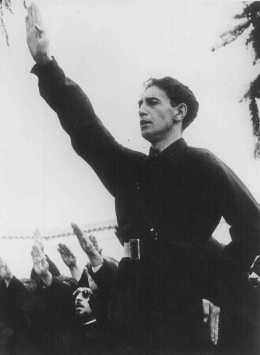
Horia Sima, the new leader of the Legion of the Archangel Michael.
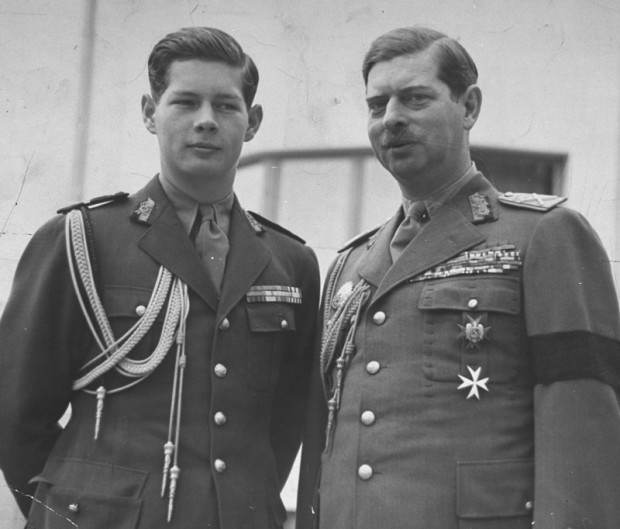
Prince Michael and King Carol II.
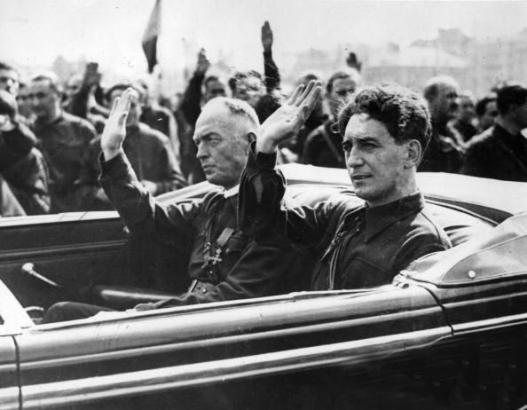
General Ion Antonescu, Conducător, and Deputy Premier, Horia Sima.
The 18-year-old prince now ascended the throne for the second time and issued a royal decree declaring Antonescu to be Conducător (leader) of the state. Antonescu lacked his own political base, and the establishment parties remained pro-British and pro-French, so he opted for a military dictatorship in coalition with the pro-Nazi Iron Guard, whom he regarded as the country’s political base. The Nazis approved of this, since they considered the Guard too weak to rule alone. The resulting regime, deemed the National Legionary State, was officially proclaimed on September 14th 1940. The Iron Guard was remodelled into a single official party: Antonescu continued as Premier and Conducător and was made Honorary Leader of the Legion, while Horia Sima was made Deputy Premier of Romania and Commander of the Legion.
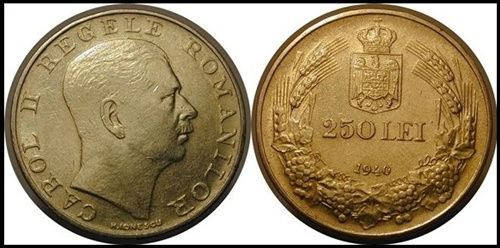
In the first half of 1940, the 250 lei was again issued with the portrait of Carol II and the edge inscription “MUNCA CREDINTA REGE NATIUNE” (“Work, faith, king, nation”).
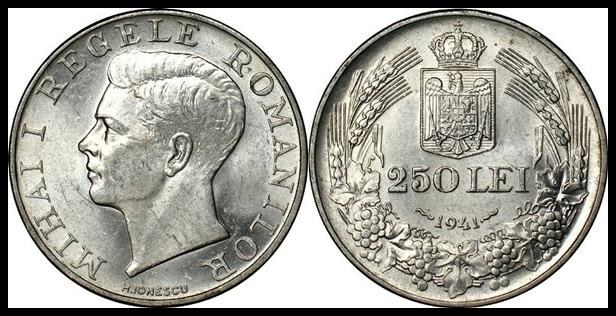
Michael, 250 lei, 1941.

In early 1941, the 250 lei was issued with the portrait of King Michael, but now the edge inscription read: “TOTUL PENTRU TARA”, meaning “Everything for the country”. This was the name of the Legion’s political party and also the slogan of the National Legionary State. The words on the edge inscription were separated by a small symbol, similar to a portcullis, that was the emblem of the Legion.
From romaniancoins.org
“The coins were released into circulation after March 19th, and withdrawn in May and June. It seems that about 94% of the coins that entered the market were withdrawn. Most probably the withdrawal was caused by the edge inscription. This issue was replaced by a new one, with NIHIL SINE DEO on the edge.”
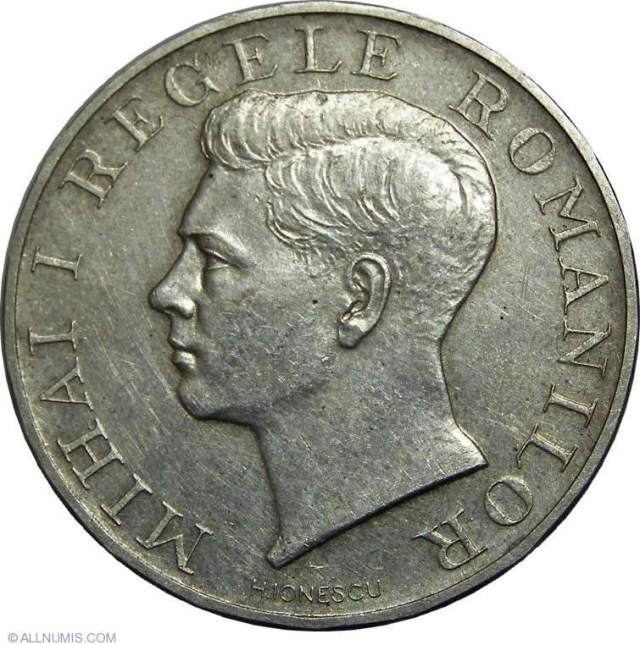
250 lei, 1940, showing King Michael.
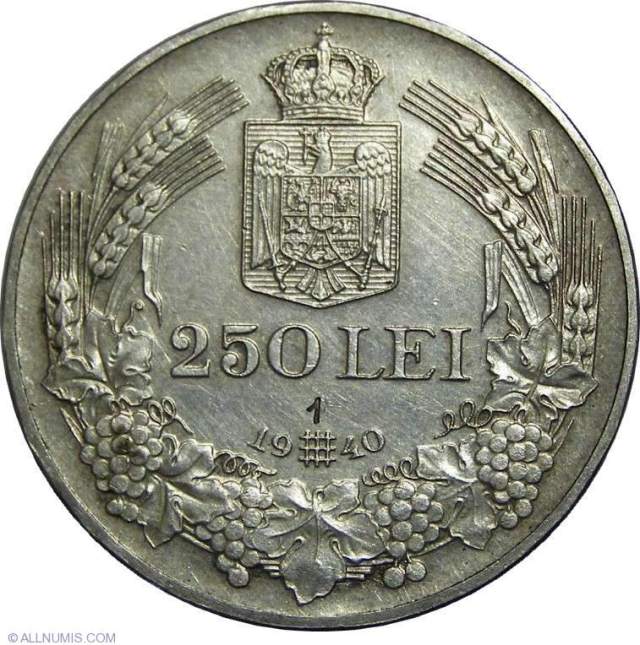
Here the date, 1940, is separated by the symbol of the Legion.
Additionally, some 250 coins of this type were produced with the date 1940 and the edge inscription “TOTUL PENTRU TARA”, but also bearing the symbol of the Legion, which separates the date. Most of these coins were melted down, but a rare few remain. You can read more about these coins here.
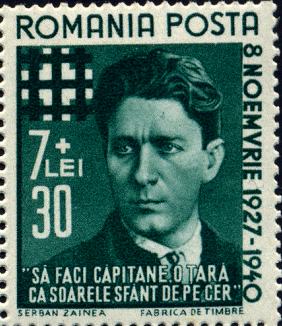
Romanian stamp, 7 lei, 1940. This stamp was issued on November 8th 1940 and commemorates the 13th anniversary of the founding of the Iron Guard by Codreanu, who was killed in 1938. The main symbol used by the Iron Guard was a triple cross, standing for prison bars and symbolising martyrdom.
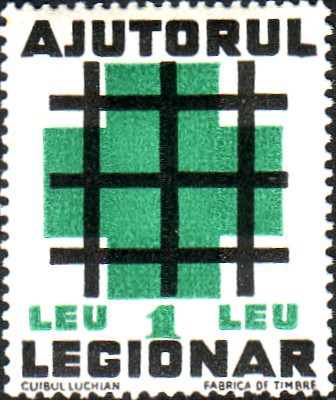
Another stamp, issued by the Legion itself, showing the movement’s symbol.
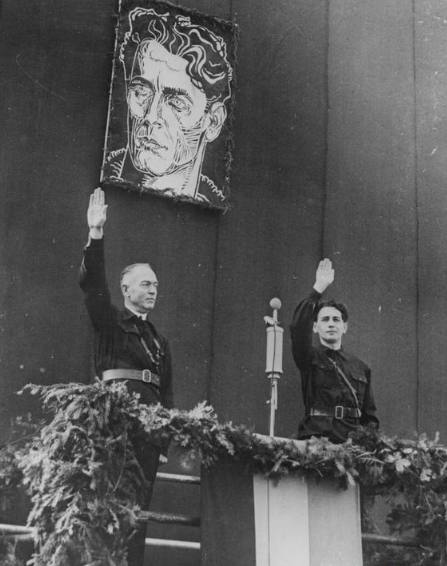
General Antonescu and Horia Sima. Both are wearing a Legionary uniform.
In late September 1940, the new regime denounced all former pacts and diplomatic agreements, bringing the country into Germany’s orbit. German troops entered the country in stages, in order to defend the local oil industry and instruct the Romanians in Blitzkrieg tactics. In November Antonescu signed the Axis-sponsored Tripartite Pact and the Anti-Comintern Pact.
Antonescu did not oppose the Iron Guard’s policies, but he was offended by its paramilitarism and frequent recourse to street violence. There was tension between the leaders due to thieving by the Iron Guard from the Jewish population. Antonescu believed the robbery was done in a fashion detrimental to the Romanian economy, and that the stolen property did not benefit the government, only the Legionaries and their associates. He held that the expropriation should be done gradually through the passing of anti-Semitic laws.
The Legionary press began claiming that Antonescu was obstructing the revolution and aiming to take over the Iron Guard. In late November 1940, after uncovering the circumstances of Codreanu’s death, the Legionaries began violent retaliations against political figures. More than 60 former dignitaries or officials were executed in Jilava prison while awaiting trial, including former prime minister Nicolae Iorga, without even the pretense of an arrest. The Guard also pursued a campaign of anti-Semitic pogroms.
Angered by this insubordination, Antonescu ordered the Army to resume control of the streets. He ousted the Iron Guardist prefect of the Bucharest Police and ordered Legionary ministers to swear an oath to the Conducător. His condemnation of the killings was nevertheless limited and discreet, and he later joined Sima at a burial ceremony for Codreanu’s newly discovered remains. The dispute between the dictator and Sima’s party alarmed Hitler, who was preparing to attack the Soviet Union and feared that any internal conflict would threaten Romania’s vital oil industry.
Meanwhile the excesses and incompetence of the Legion were eroding its popularity with the public. The Legion’s “national socialism” subjected labour to hierarchical control and caused mounting economic disarray that provided no advantages to workers.
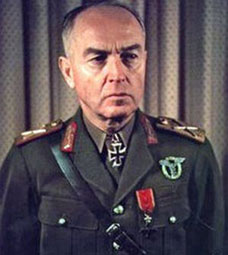
On 14th January 1941 Antonescu visited Germany to meet Hitler, who agreed to the elimination of his opponents in the Legionary Movement. Returning to Romania, on 19th January Antonescu issued an order cancelling the position of Romanian-isation Commissars: well-paying jobs, held by Legionaries. Additionally, he fired the Legionaries responsible for terror acts, from the Minister of the Interior to the commanders of the Security Police and the Bucharest Police. He appointed loyal military men in their place. The military also took control of strategic installations, such as telephone exchanges, police stations and hospitals. The district officers, who were Legionaries, were then called to the capital for a meeting, where they were arrested.
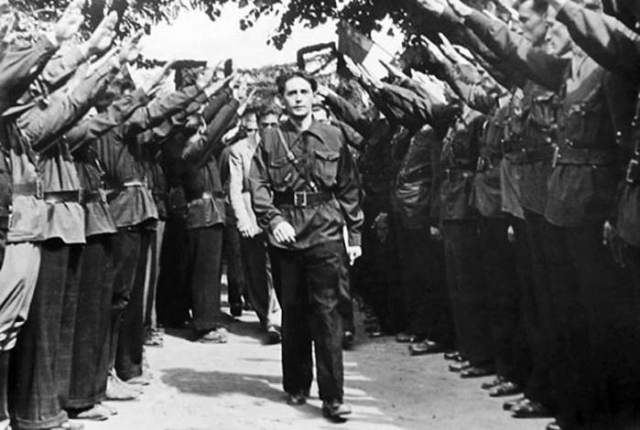
The issue was who would rule Romania, and Sima overplayed his hand. As their privileges were being cut off, the Legionaries erupted into an orgy of violence. The so called Legionaries’ rebellion, including the bestial violence of the Bucharest pogrom, occurred between 21st and 23rd January 1941. Armed Legionaries captured the Ministry of the Interior, police stations and other government and municipal buildings, and opened fire on soldiers trying to regain these buildings. The Legion organised mass drafts at neighbouring villages, and masses of peasants flooded the streets of Bucharest in response to the Legion’s call to defend Romania against the “Jews and Freemasons”.
In all, the Legionaries killed 30 soldiers and at least 125 Jews. On January 24th 1941, with Hitler’s approval and the support of the army and other political leaders, Antonescu moved in. The Guard attempted a last-ditch coup, but no fascist movement was ever a match for an organised army. In a three-day civil war, with support from the Romanian and German armies, Antonescu won decisively. The Legion was banned and 9,000 of its members were imprisoned. Antonescu then proclaimed Romania a “National and Social State,” with himself as sole dictator.
Hitler granted political asylum to Sima – whom Antonescu’s courts sentenced to death – and to other fleeing Legionaries. They were detained in special conditions at Buchenwald and Dachau concentration camps. Antonescu’s government took anti-Semitism even further than the Iron Guard and became infamous for its participation in the Holocaust.
After the war, Sima fled to Spain, where he remained unpunished for his atrocities and died of old age in Madrid in 1993. In 1946 Antonescu was found guilty of treason by the Romanian communist government and executed by firing squad. In 1947 King Michael was forced to abdicate by the Romanian government. He settled first in Italy, then England, then finally in 1956 he made his home in Switzerland. He died there, aged 96, on 5 December 2017.
NOTE: After the demise of the Legion, new versions of the 250 lei coin were minted in 1941, with a portrait of King Michael and the edge inscription “NIHIL SINE DEO”, which was King Michael’s motto and is Latin for “Nothing without God”.
See also:
1] Iași pogrom.
2] King Michael’s Coup.
All fascist regimes are doomed to self-destruct, because they are so extremist that they believe in all or nothing, and they are so aggressive that they inevitably make too many enemies and are defeated. Mussolini’s regime took 22 years to self-destruct. Hitler managed it in only 12 years. The National Legionary State lasted from September 6th 1940 to January 23rd 1941, a mere 131 days. Ultimately they achieve nothing other than violence, murder, and mass agony. Sadly, the Legion was survived by Ion Antonescu, who was made a Marshal of Romania in 1942 and, though he was a military dictator and technically not a fascist, he was as brutal, barbaric and bestial as any fascist.
Sources:
1] Wikipedia
2] “A History of Fascism, 1914–1945”, by Stanley Payne.
